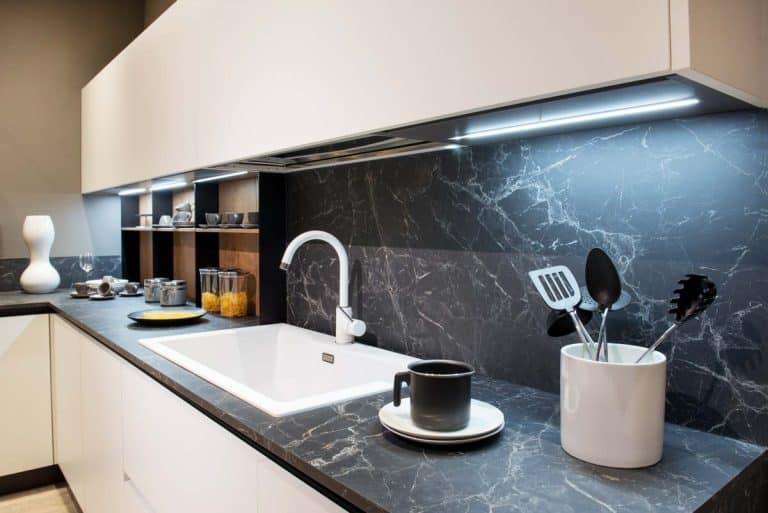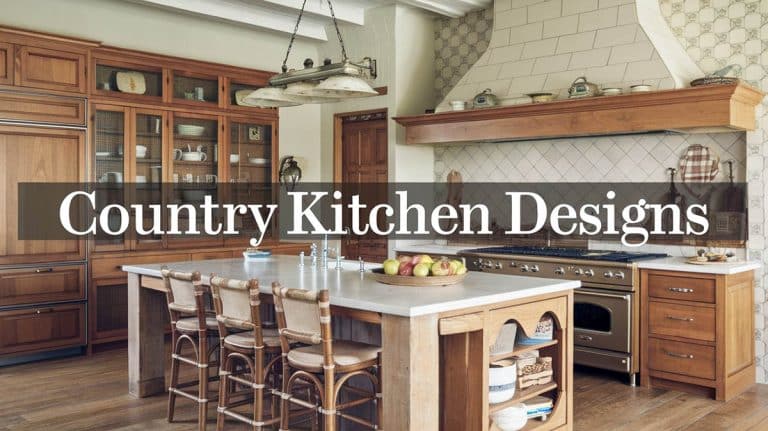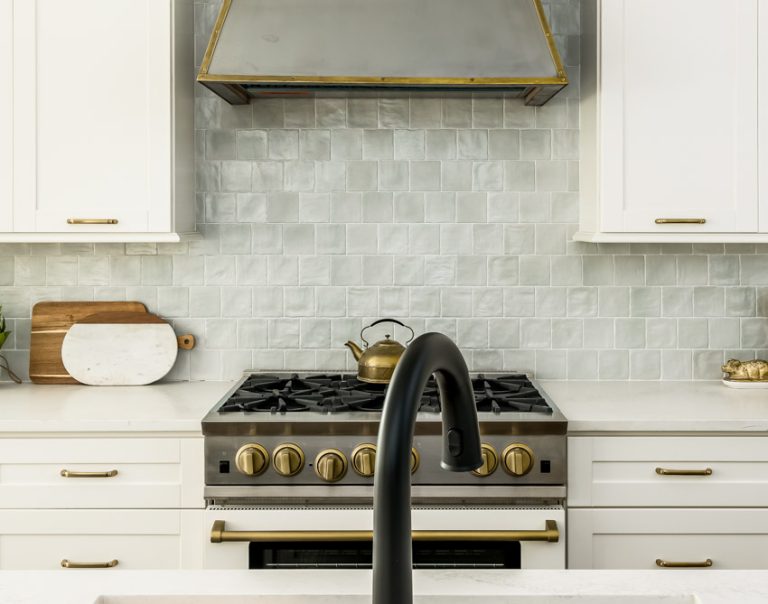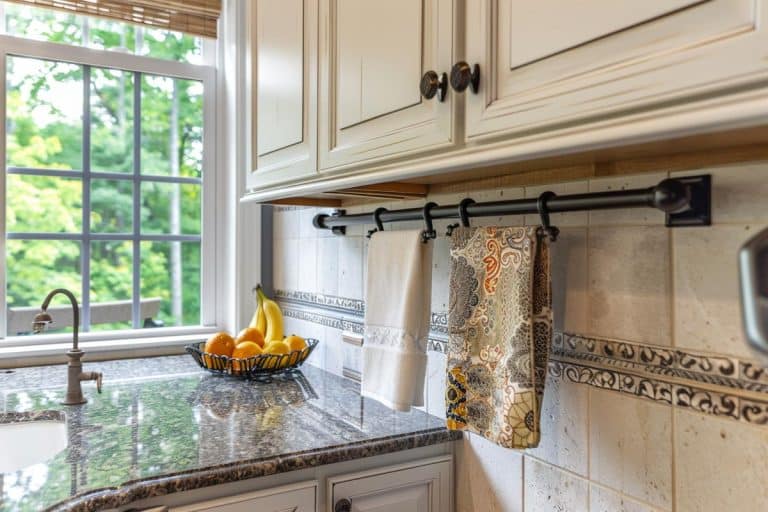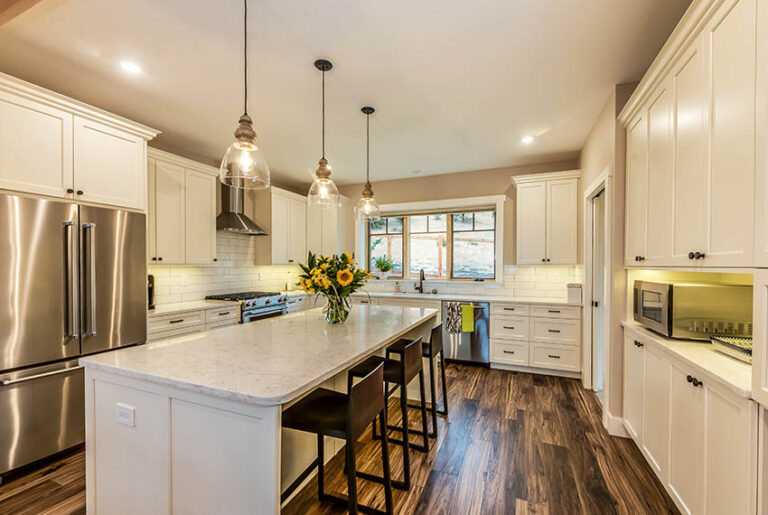Types of Kitchen Countertops (Image Gallery)
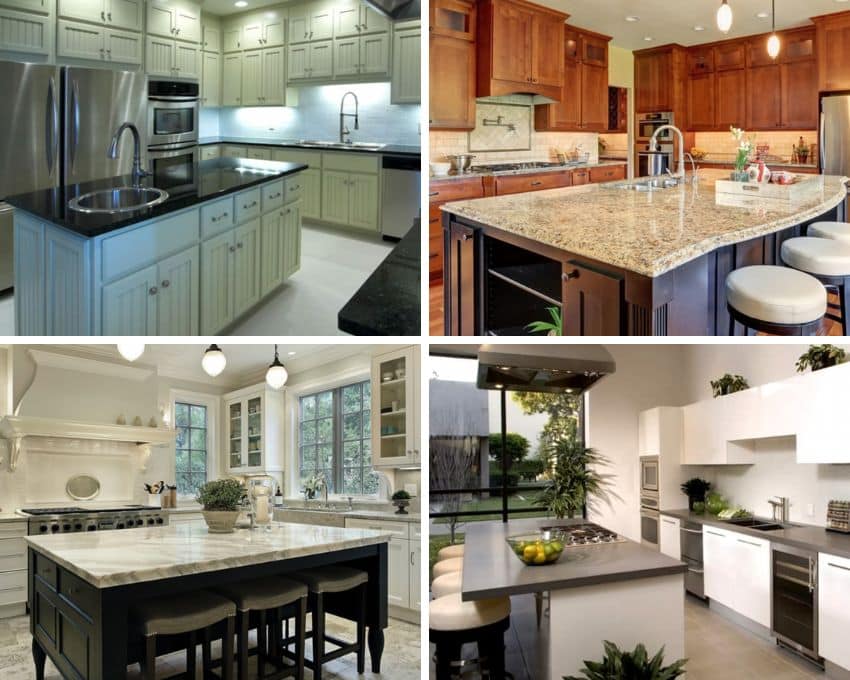
With so many different types of kitchen countertops it can be a challenge to find the one that best suits your kitchen. Your kitchen counter is your main work space and can be a focal point of your kitchen.
Durability, resistance to moisture and aesthetics are some of the main factors to be considered when choosing the right countertop materials, but there are other positive characteristics that you need to look out for to make sure you get the best worth of your pennies.
Below is our very own ultimate guide on the different types of kitchen countertops to help you select the best options and materials for your home design.
| Quicklook: Different Countertop Types For Kitchens | |
|---|---|
| Granite | Glass |
| Marble | Recycled Material |
| Quartz | Soapstone |
| Laminate | Resin |
| Wood | Tile |
| Stainless Steel | Concrete |
Granite Countertops
Granite is a coarse grained igneous rock that is made up of interlocking mineral crystals like quartz, feldspar and mica. Its material make up greatly varies depending on the type, making each piece of granite slab unique. They are quarried from the earth and cut into slabs for use in your home.
Granite can come in white, gold, gray, tan, metallic, black, red, green and blue – and even in combinations of these colors. A honed granite counter has a soft, matte finish with a smooth surface and very if any reflection in the stone. Like granite counters, a honed granite counter is very durable and resists scratching, cracking and chipping. Honed granite is also heat-resistant.

Granite kitchen countertops are scratch-resistant (when sealed and treated), heat-resistant, stain-resistant and offers natural protection against mold and mildew. Granite also offers you an extensive natural color palette to choose from.
On the other hand, while durable, granite does have its fragility in the way of corners. The corners that extend over the edge of your cabinets are vulnerable to chipping. If a corner chips, you will likely need to hire a professional to make repairs.
Granite countertops will also need to be resealed from time to time to retain its stain-resistant properties. This is because granite is naturally porous, meaning that it will absorb spills if it isn’t sealed, poorly sealed, or if the seal has worn off.
This should be done annually, but if you spend the extra for treated granite, you may be able to go as long as 10 years without resealing. Unfortunately, granite is already a fairly high-priced choice.
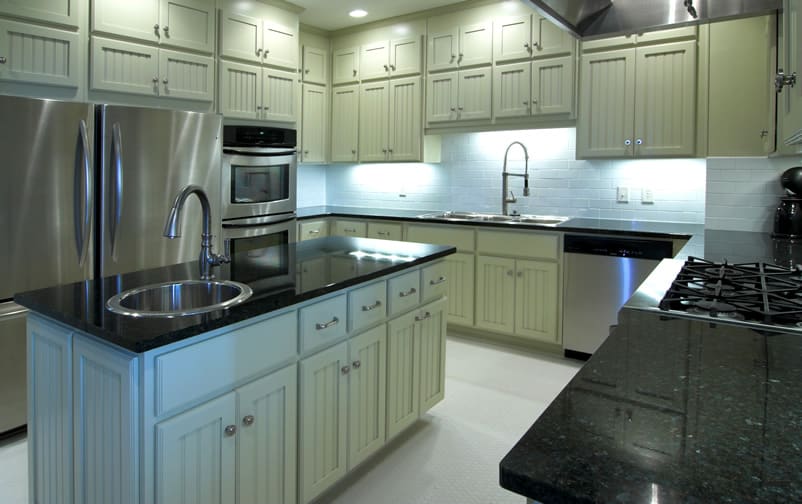
Granite countertops come in two different finishes, polished granite and honed granite.
Polished granite – Polished granite has a glossy sheen that provides an extremely durable surface. Polished granite countertops are popular because they give kitchens a high end look.
Honed granite – With a honed granite finish the stone is not buffed to become polished, but rather left with a matte or low-gloss sheen. This provides a more natural or aged style that has become more popular with homeowners. However, this type of finish requires more maintenance than a polished finish.
Pros and Cons of Granite Countertops
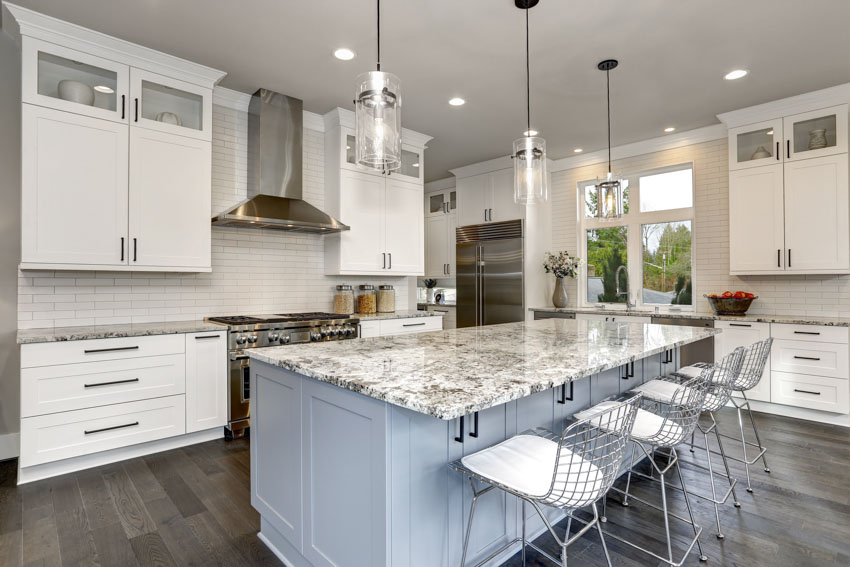
Here are some of the best benefits granite countertops offer:
Granite Countertop Pros
Sustainability – A single quarry site can provide stone for thousands for decades. Granite is 100% natural, making it an eco friendly option. Once quarried, it takes very minimal processing to prepare it for other applications.
Because of its very near complete state as countertop material, the production process does not involve the emission of toxic chemicals and harmful substances, thus reducing exposure.
Durability and Scratch Resistance – Granite is one of the hardest stones and has a rating of 7 in the Mohs Scale of mineral hardness. Very few minerals can scratch it but experts still recommend that you use a cutting board so that your knives don’t get dull.
Heat Resistance – Granite countertops have incredible resistance against high temperatures. It will not melt nor blister when it comes in contact with hot pots and pans. However, experts still recommend using trivets when using hot appliances for long periods of time.
Hygienic – Natural resistance to molds and mildews; and does ot harbor the growth of harmful bacteria.
Chemical Resistance – Unlike marble, granite countertops are resistant to chemicals and acidic substances like vinegar.
Wide availability of colors – Granite offers a wide variety of colors which can fit different interior design styles and schemes.
Granite Countertop Cons
Although granite is extremely durable, it still comes with a few disadvantages and weaknesses.
Whole slab needs to be replaced if damaged – Although very durable, granite countertops can still get damaged when hit hard by a sharp object like a meat cleaver.
The corners of a granite countertop are also vulnerable to chipping and chips need to be done by a professional. Repairs can be quite hard because the whole slab needs to be replaced.
Inconsistent color – Since granite stones are quarried from the earth, each slab is different and the color is less uniformed compared to engineered stone.
Requires periodic sealing – All natural stone countertops require to be sealed to give them an added protection against moisture and spills.
Granite is naturally porous and if liquids are left in its surface for a long period of time, they have the tendency to seep into the material. Thus, they need to be sealed before use and resealed annually to ensure their quality.
Colors of Granite
Granite typically comes in neutrals like white, gold, gray, tan, golds, brown and black. But it also comes in more exotic colors like red, green and blue, sometimes even in combinations of these colors.
The more minerals there are present in a slab, the more diverse the colors present in the stone. White granite, for example, has white feldspar in it, while black granite has an abundance of mica. White granite with gray veins have both feldspar and quartz in them.
All natural stones, including granite, have limited colors and patterns. But even though the colors are less compared to synthetic materials, the granite colors are extremely unique. Solid colors are rare to find but exotic patterns like huge flowing waves, sparkling flecks and metallic specks are common.
Cost of Granite
Granite is considered to be an average priced countertop material with its slabs starting around $35 to $55 per square foot. However, more exotic variants that fall on the high end range can reach over $400 per square foot.
On average, a typical kitchen countertop costs around $3,00 to $4,000 depending on the size of the space, design, finish, edge profile, and type of granite used.
Maintenance for Granite
In terms of maintenance, granite is considered to be a low maintenance countertop material. The need to be repaired is very low and the majority of granite countertops can last for decades without having to be replaced.
Although it needs to be periodically sealed, sealers have significantly improved over the years with some brands lasting for over a decade before the need to be reapplied. Most sealers do not also require professional service since application is very simple and easy.
Marble Countertops
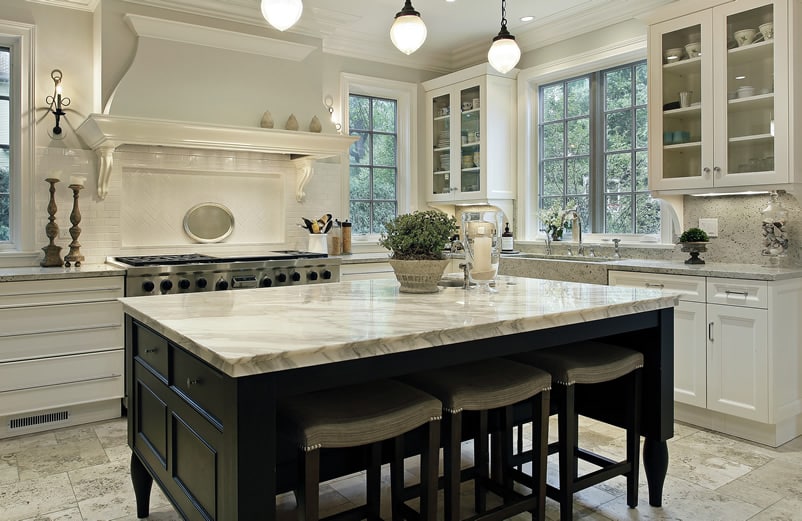
Marble is a type of metamorphic rock that is composed of recrystallized minerals like calcite, calcium carbonate or calcium magnesium carbonate and dolomite. Marble starts as limestone or dolostone then transforms into a new mineral through exposure to high heat and pressure. This process gives marble its distinct veiny appearance
The smooth natural gloss and the distinctive veining of marble make it a beautiful material to use in a kitchen counter. As long as you take special care with acidic substances, the creamy surface of marble should last you a long time.
There are several advantages and disadvantages to installing marble kitchen countertops in your home. Lets start off with the benefits. For starters marble looks great in the kitchen. It offers a classic beauty you will definitely enjoy.
Additionally marble is naturally cool and not a big heat conductor. So if you do a lot of baking that’s a big plus. Marble is also heat resistant. Finally it is widely available for purchase.
Now on the negative side marble is a softer stone which is prone to stains an scratches. Sealing can help protect your stone surface, hover etching can still be a problem. And that brings us to maintenance which the above mentioned sealing should be done about once a year depending on how busy you are in the kitchen.
Pros and Cons of Marble Countertops
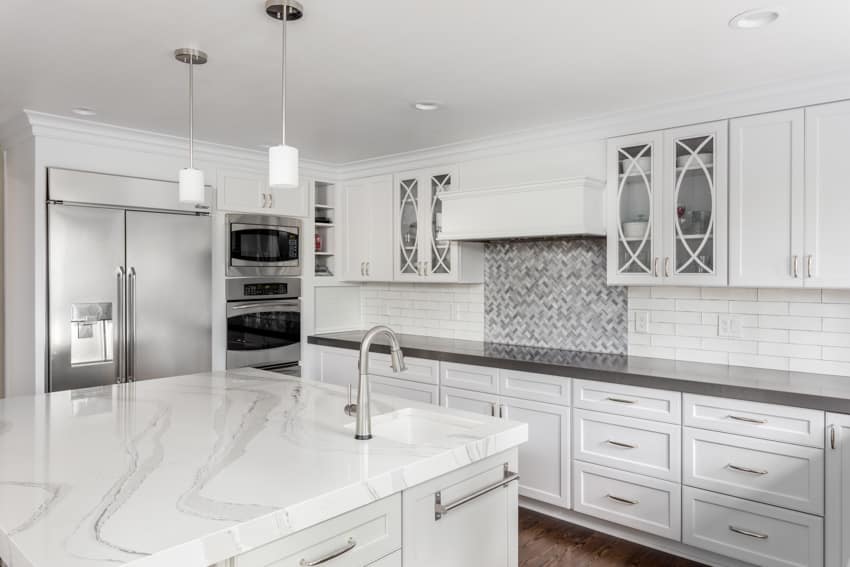
Marble Countertop Pros
Offers a high end look – Marble is known to be one of the moist luxurious natural stones. It gives off a very timeless, classic vibe that can instantly make kitchens look elegant and sophisticated.
High durability – Marble is structurally durable and will not wear and tear easily despite constant daily use.
Stands the test of time – Provided that your marble countertops are properly cared for and maintained, they will not fade in looks nor in value even for decades.
Available in classy neutral colors – Marble countertops come in timeless neutral colors which match a variety of interior design styles — from traditional to modern kitchens.
Adds resale value to a home – Natural stone countertops like marble can significantly increase a home’s resale value and can result in 200% return on investment when the property is sold.
Naturally cool – Although not a big heat conductor, marble is naturally cool and can be beneficial if you do a lot of baking in your kitchen.
Marble Countertop Cons
Prone to etching – Etching happens when the surface of marble countertops come in contact with acidic substances like vinegar, wine, alcohol, citrus and coffee. This produces physical damage, dulling and discoloration on the stone.
Marble is softer than other natural stones – Because marble is made up of calcite, it is softer than other natural stones, thus more susceptible to stains and watermarks.
Marble needs to be sealed on a regular basis- Because marble is a natural stone, it is porous and needs to be sealed before use. It also requires special care with acidic substances and other spilled liquids.
Installation must be done by a professional – Installation of marble countertops must be done by a professional because it requires precision.
Colors of Marble
Marble is usually a light colored stone. The purest form of marble is white in color but when it comes in contact with other minerals, the resulting stone will have swirls and veins in different color variations.
The most popular color of marble comes with a white base and gray veins. You can also find other neutral colors like black, shades of gray and browns. More exotic colors include blue, green and yellow marble.
Cost of Marble
The average cost for marble slab countertops is $60 per square foot, but there are less inexpensive options at $40 per square foot. High end varieties can range from $100 or more per square foot.
Carrara marble, one of marble’s most popular varieties, is sold at $40 per square foot. Calacatta marble, one of the most expensive natural stones in the market, is priced at around $180 per square foot.
Maintenance for Marble Countertops
As long as you maintain and take special care of your marble countertops, the original beauty and natural gloss of this luxurious natural stone can last you a long time.
In general marble countertops require more maintenance compared to other natural stones because they are more porous. Similar to any natural stone, marble countertops need to be sealed and resealed periodically to ensure that they last for years. Sealing will prevent any liquids from seeping through the marble countertop. Typically, sealing is done about once every year.
On a regular basis, use a natural cleaning agent that is specifically designed for use on marble. Avoid household cleaners because marble is very sensitive to specific substances and may cause surface etching. Read more about cleaning marble countertops here.
Quartz Countertops
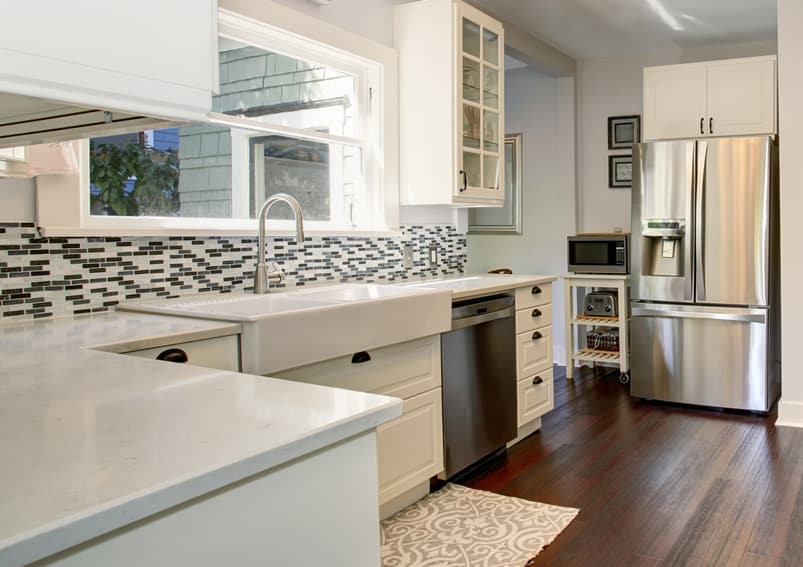
Quartz countertops are often confused with the natural stone quartz. Quartz countertops are a type of engineered stone that is made of 90% crushed up natural materials such as granite and marble with recycled industrial offcuts of silica, glass and ceramic. The remaining 10% is a type of cement based or polymer binder, combined with resins and pigment. This gives it inherent durability and hardness.
Quartz countertops resemble solid surface countertops, but contain a higher percentage of mineral matter versus binders. – Black & Decker The Complete Guide to Cabinets & Countertops, Editors of Cool Springs Press
Quartz is one of the hardest surfaces on earth and is naturally non-porous and scratch resistant. It’s pretty too, with multi-dimensional gem-like coloring in a variety of shades Quartz has anti-microbial properties inhibit the growth of bacteria, mold and mildew.
Some of the benefits of a quartz kitchen countertops over granite are the following. To start with quartz has a very uniform and controlled appearance. Slabs are produced and crafted with a lot of evenness through the stone.
They are also very strong naturally, and when combined with a resin binder can be stronger than both granite and marble. This stone is also non-porous unlike granite or marble which makes it very stain resistant and easy to use and maintain.
It’s important to note that while quartz countertops have all the benefits we’ve looked at here, there are some drawbacks to it as well. While quartz is especially strong, they have similar downfalls to granite countertops.
The corners of your counter might chip easier and if they do, it usually requires a professional repair. You can reduce this risk by installing a countertop with rounded edges rather than ones with a 90-degree corner.
Pros and Cons of Quartz Countertops

Here are the top benefits and drawbacks of using quartz countertops in your kitchen design.
Quartz Countertop Pros
Durability – Quartz is impressively hard because of its material composition which is 95% natural quartz and 5% resin cement base binders. It does not chip, rack or break easily.
The addition of resin binders reinforces the inherent hardness and strength of the material making it a very reliable countertop material.
Heat, scratch and stain resistance – Quartz countertops are the most forgiving when it comes to damages like dents, scratches, chips and cracks. Because of its inherent hardness, it will not get scratched by sharp tools, knives and abrasive pads.
When in contact with hot pots or pans, the surface will not get damaged. In addition to heat and scratch resistance, quartz countertops also stand up well to spilled liquids.
Non porous and resistant to moisture – Quartz has a low absorption rate of 0.5% because of the resin binders that make it impenetrable to moisture.
Hygienic – Because it is resistant to moisture, there is no water buildup which causes bacterial growth. Quartz countertops do not also harbor molds and mildew because there are no seams and grout lines.
High end visual aesthetics – Quartz is often manufactured to mimic natural stones like granite and marble and works as a good alternative.
Consistent color and uniform appearance – Quartz is produced as an almost perfect material. Since it is man made, the color is more consistent and the appearance is more uniformed because of its through and through body composition. It is the perfect choice for those who want a seamless kitchen design.
Low maintenance and does not require sealing – Unlike natural stones, quartz countertops do not require sealing. It also requires very minimal effort to maintain.
Long lasting – Quartz countertops can last for decades if properly maintained. Most manufacturers offer them with a 10 to 15 year warranty.
High versatility and design flexibility – Quartz countertops can be customized in any form, size and design. It matches a variety of interior design styles and the colors available are endless.
Quartz Countertop Cons
Not suitable for outdoor use – Quartz countertops are not suitable for outdoor kitchens because exposure to direct sunlight can cause surface discoloration. Excessive heart from the sun can also cause it to warp eventually.
Cannot take extreme heat – Quartz countertops are heat resistant but only upto a limit –anything above 300 degrees fahrenheit can damage its surface.
Edges have the tendency to chip – The corners of your counter might chip easier and if they do, it usually requires a professional repair. You can reduce this risk by installing a countertop with rounded edges rather than ones with a 90-degree corner.
Colors of Quartz
Because quartz is manmade, it is available in almost any color. During production, pigment is added to the powdered quartz and resin mixture producing a wide variety of colors. Each brand offers unique lines and collections of quartz countertops , giving homeowners and designers a lot of options.
The colors for quartz countertops vary depending on the brand, but generally they are available in mostly neutrals and earth toned colors like white, beige, shades of brown, grays and black. For those who prefer a more lively color, there are options like green, blue and rich tones of copper, gold and red.
Quartz colors are also very eye-catching and have a multi dimensional, gem like appearance. Sometimes, these designs and colors mimic the appearance of natural stones like granite, marble, etc.
Cost of Quartz
Quartz countertops are less expensive than other countertop materials, with average costs running anywhere between $50 to $100 per square foot, depending on factors like design, brand and color.
The price range for quartz countertops can also be classified into three general groups, standard, premium and designer quartz.
Designer quartz or high end quartz costs as much as $70 to $100 per square foot excluding installation, while premium quartz falls in the $60 to &70 price range. These quartz have richer patterns and colors.
Standard quartz, or quartz that have plain and solid colors, is the most affordable of the three and costs around $50 to $60 per square foot.
Maintenance of Quartz Countertops
Quartz countertops require the least amount of maintenance among different countertop materials. They do not require any special cleaning tools and solutions to keep it clean and looking good. All you need to maintain quartz countertops is a soft cloth and mild detergent to wipe it down after use.
An added bonus is you do not need to seal or reseal it every couple of months to protect it from spilled liquids because it is already non porous.
Laminate Countertops
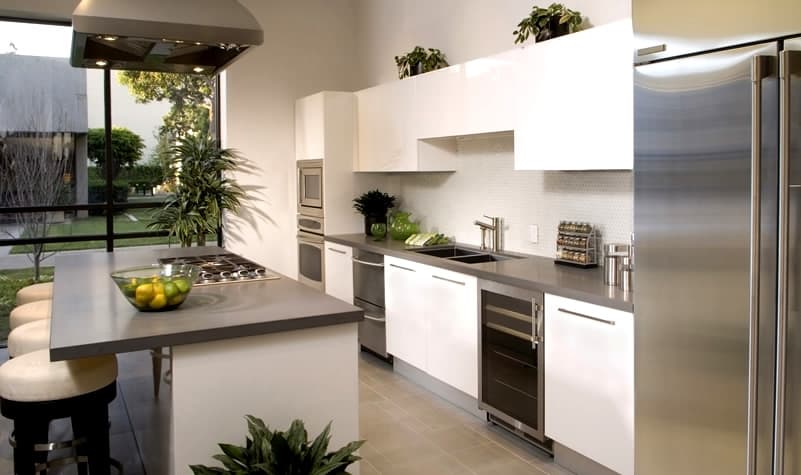
Laminate is still used in 80% of European homes and for good reason. Laminates are made of layers of kraft paper and plastic resins which are pressed together and heated to form a thin, durable decorative layer. This layer is then attached to a substrate like plywood or MDF to create a sturdy workspace. Laminates typically come in 8mm, 10 mm and 12 mm thicknesses.
Laminate counters are tough, affordable and easy to care for – just wipe them down with soap and water. Laminate comes in a variety of designs, patterns colors making it easy to find a counter that will complement your kitchen design.
Just a few reasons home owners choose laminate is due in large part to the low cost, how long lasting, as well as how low maintenance, and easy to clean it is. Laminate is still used in 80% of European homes and for good reason.
That being said, laminate – like any other material- is not a completely perfect material. For one, you’ll want to make sure you always use a cutting board. Sharp objects like knives can easily create permanent damages in the countertop.
You’ll also want to make sure that you lay barriers down between any hot pots or baking pans that you place on your counter. While laminate countertops have mild heat resistance, they are made of plastic which can melt when exposed to extremely high temperatures.
While your morning cup of coffee won’t damage laminate countertops, you might see damage occur if you’re laying hot trays of cookies or frying pans directly on it.
Pros and Cons of Laminate Countertops
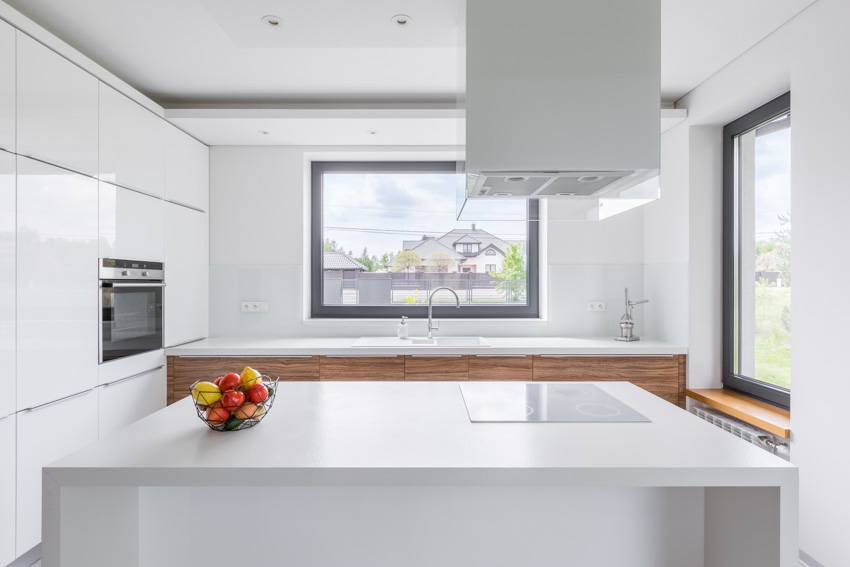
Laminate Countertop Pros
Tough – Laminate counters are tough and can withstand daily wear and tear.
Affordable – Laminate countertops are a budget friendly option.
Easy to care for – Laminate countertops are low maintenance and easy to clean –just wipe them down with soap and water. No sealing is also required to keep them protected and looking great.
Comes in a variety of designs, patterns colors -Laminate countertops are available in vast amounts of design options and color, some of which mimic the appearance of granite, marble, wood, etc. making it easy to find a counter that will complement your kitchen design.
DIY friendly – Making laminate countertops involves straightforward procedure that does not require professional installation.
Laminate Countertop Cons
Can be damaged by sharp objects – You’ll want to make sure you always use a cutting board. Sharp objects like knives can easily create permanent damages in the countertop.
Not heat resistant – You’ll also want to make sure that you lay barriers down between any hot pots or baking pans that you place on your counter. While laminate countertops have mild heat resistance, they are made of plastic which can melt when exposed to extremely high temperatures.
While your morning cup of coffee won’t damage laminate countertops, you might see damage occur if you’re laying hot trays of cookies or frying pans directly on it.
Can be damaged by too much moisture – Moisture can penetrate the seams of laminate countertops and can cause delamination.
Has no resale value – Although laminate countertops today have significantly improved in terms of patterns and designs, they still do not have any resale value. Natural stone countertops are still very much preferred by potential buyers.
Colors of Laminate
Laminates are manufactured in a wide assortment of colors, designs and patterns. In fact, there are hundreds of options per brand because each manufacturer produces their own line of collections.
Laminate countertops come in solid colors and designs that often mimic the appearance of natural materials like wood and stone. They also come in a variety of textures like grained, embossed,matte and glossy.
Cost of Laminate
Laminates are the most budget friendly option for countertops with prices ranging as low as $10 per foot to $50 for custom made countertops. The average cost for both the material and installation is around $30 per square foot, depending on the design.
Costs can even run lower if you choose to go with stock laminate countertops. These are pre cut laminate tops that can be modified to fit your kitchen. You can also save on labor and installation if you choose to do it yourself.
Maintenance of Laminate Countertops
Laminate countertops require very minimal effort to maintain. Unlike natural stone countertops, laminates do not require sealing. Daily maintenance can be done using mild soap and water.
However, there are a few preventive measures you need to observe to prevent damages like keeping knife edges and hot pans from being in contact with the surface.
Make sure to use trivets, hot pads and cutting boards when doing prep work on laminate countertops. Also, avoid using abrasives and harsh cleaners because they can damage the surface permanently.
Wood Countertops
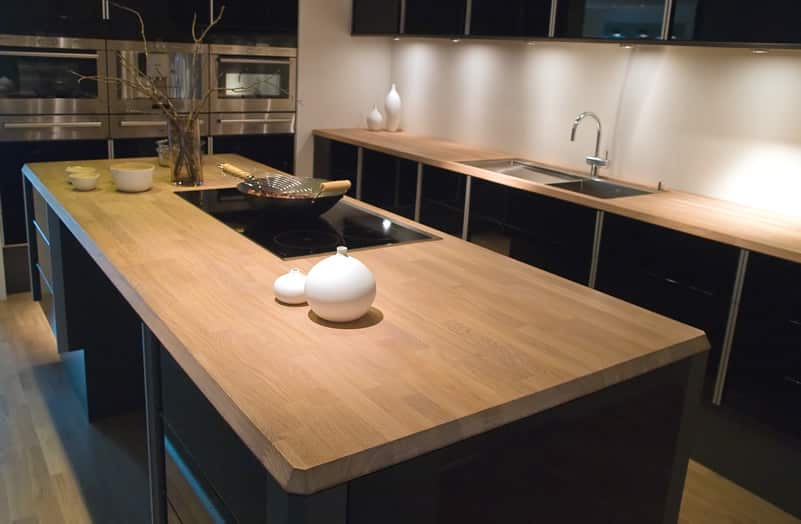
Wood countertops are one of the most well loved countertop materials because of their warm, natural appeal of wood counters lends a cozy, homey touch to kitchens.
Sometimes referred to as “butcher blocks”, wood countertops are a type of work surface that is similar to an actual cutting board in a butcher shop. Typically several inches thick, butcher blocks are constructed from hundreds of square pieces of wood that are glued together so that their ends create a strong surface
The warm, natural appeal of wood counters lends a cozy, homey touch to kitchens. Wood is also highly heat-resistant so you don’t have to worry about putting hot pots or pans on a wood counter.
One caveat to consider is wood does require a lot of maintenance in the kitchen area. Sealing is mandatory with a product like Aqua spar and will need to be done regularly to keep your wood counters looking attractive for years to come.
Installing wood kitchen countertops can be less expensive than many other types of materials. In addition wood has natural, anti-bacterial benefits when sealed properly.
Although one drawback of wood is, it will need to be sealed several times a year depending on the finish. Wood also must be kept dry, which will keep you on your toes after a spill or watchful of the sink areas.
Pros and Cons of Wood Countertops
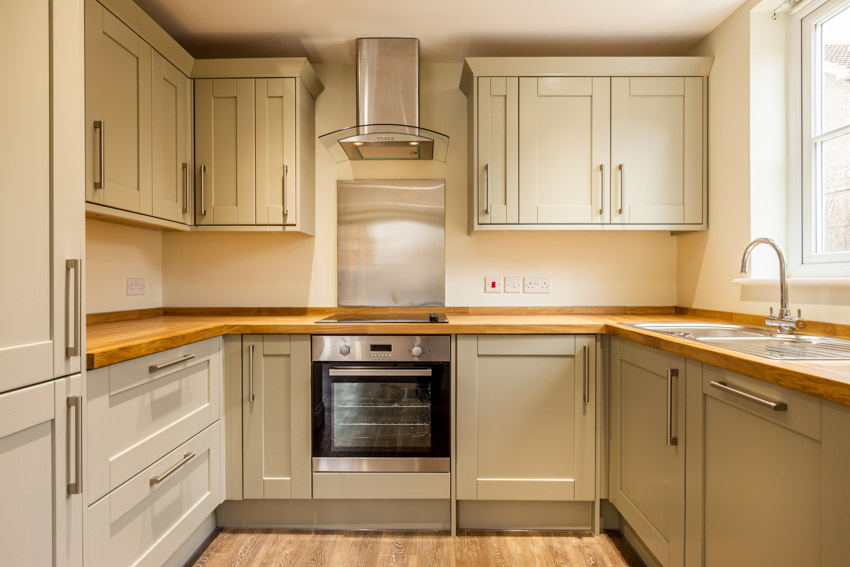
Wood Countertop Pros
Appealing and high visual aesthetics – There is no other material that can match the distinct natural beauty of wood. Wooden countertops can make a kitchen feel warm and inviting.
Heat Resistant – Wood is also highly heat-resistant so you don’t have to worry about putting hot pots or pans on a wood counter.
Budget friendly option – Installing wood kitchen countertops can be less expensive than many other types of materials like natural stone and engineered stone. For example, a butcher block made from beech or birch costs a little more than laminates and less than half the minimum price of natural stone.
Antimicrobial – Wood has natural, anti-bacterial benefits when sealed properly.
Easy to install – Prefab butcher blocks are easy to install and can be modified to fit around sinks, corners and appliances uncomplicatedly. Finishing Wooden countertops also involves a very straightforward process.
Strong and durable – Wood is one of the most reliable construction materials available. Provided that it is properly cared for, it can last for decades.
Can be easily repaired – Damages like knife scratches, burn marks and other marks can be easily refinished and restored by sanding and restaining.
Has less noise – Because wood is softer than stone, there’s no clatter when you set down dishes or utensils on it. Dropped dishes are also less likely to break. In addition, wood countertops quiet down the noise from appliances while stone amplifies it.
Wood Countertop Cons
Requires more maintenance – Wood needs to be sealed every five years or so to give it added protection and to prevent liquids from seeping into its surface. Unfinished counters need to be oiled monthly while factory finished counters need to be recoated on a regular basis to keep it looking attractive.
Not moisture resistant – Spilled liquids can penetrate wood and cause cracks, stains and other damages so make sure to wipe them right away. Treating the wood and giving it a top coat will protect it from rotting, molds and mildew.
Prone to expanding and contracting – All types of wood contract and expand when exposed to varying changes in temperature, humidity and moisture.
If not properly maintained, wood countertops can warp, cup and move. So when choosing your wood countertops, make sure to opt for the right thickness — the thicker the wood is, the more stable.
Colors of Wood
Wood comes in different shades of brown, but the undertones present will vary depending on the species of the wood. Cherry wood, for example, is reddish brown in color, while oak has a yellowish tinge to it. Generally wood colors can be classified into brown, white, yellow, beige, gold, gray, red and cream.
Cost of Wood Surface Countertops
Wood countertops cost anywhere between $12 to $200 per square foot, for the material alone, depending on the species, thickness and finish. Installation labor for wood kitchen countertops cost an additional $5 to $30 per square foot.
Maintenance for Wood Countertops
Wood countertops require more maintenance compared to stainless steel and laminate countertops because they are not impervious and can be damaged from changes in moisture, humidity and temperature. However, if the material is properly sealed and coated before use, daily cleaning is a breeze.
To clean and sanitize the surface of wood countertops, use a damp cloth with a small amount of dish detergent and rinse it by wiping with a damp cloth. To sanitize, spray a solution with 1 part vinegar and 4 parts of water and let sit for 10 minutes. Wipe with a clean cloth and let dry. This can be done daily to keep your wood countertops looking attractive and germ free.
To remove stains and odors, a natural homemade cleaner using table set and lemon is your best bet. Sprinkle the affected area with table salt and rub it with a lemon quarter. Let the mixture sit for a few minutes and wipe with a clean damp cloth.
Make sure to avoid harsh cleaners with bleach and ammonia because they can raise the wood’s natural grain.
Waterproofing and sealing is another maintenance procedure required for wood countertops. You can seal wood countertops with a butcher block oil but this will require frequent reapplication to maintain the water resistant seal.
Waterlox is an example of wood sealer that keeps water from penetrating into the wood while creating a durable surface and maintaining the natural beauty of wood.
Stainless Steel Countertops
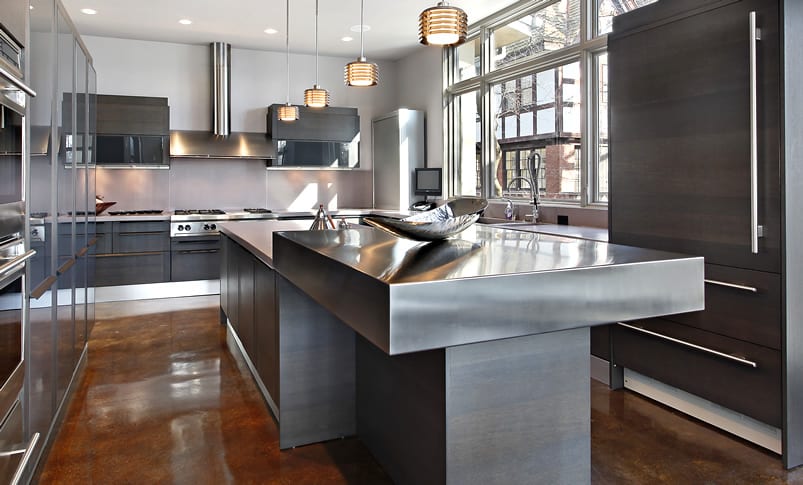
Stainless steel counters are typically found in professional chef kitchens, industrial kitchens and restaurants. Often referred to as a “workhorse kitchen”, stainless steel counters can stand to the test of time, enduring the most wear and tear.
Stainless Steel counters are a favorite of serious chefs and cooks mainly because stainless steel inhibits bacteria build-up making these countertops the most hygienic available. This ultra-heat resistant material doesn’t stain and is easy to clean and sanitize.
Stainless steel is a type of metal — an alloy of iron and chromium to be exact. All stainless steel resist rusting and corrosion because they contain iron.
Something to consider is stainless does scratch easily and is quite expensive. However, installing a brushed stainless steel countertops can help cut down on any scratches.
Advantages and Disadvantages of Stainless Steel Kitchen Countertops
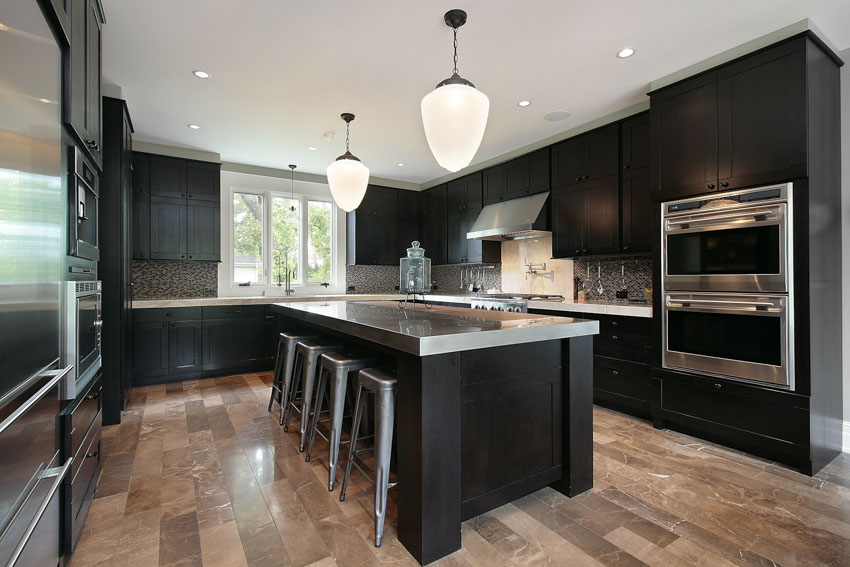
Stainless Steel Countertop Pros
Nearly indestructible material – Since stainless steel is a type of metal, it is incredibly strong, durable and nearly indestructible.
Water resistant – Stainless steel is non porous and will not get damaged from spills.
Will not burn or rust – Unlike other countertop materials such as natural stone and wood, food grade stainless steel resists both heat and You can place a hot pot on the surface and it will not get scorched.
Impervious to stains – Stainless steel countertops don’t stain and will not absorb any form of liquid.
Recyclable – Stainless steel is 100% recyclable.
Hygienic – Stainless steel countertops inhibits bacteria build-up and are considered to be the most hygienic countertop material available
Easy installation – Installation is easy and there is no need for a sealing process
Stainless Steel Countertop Cons
Noise – There’s clashing and clanging when cookware memes contact with a stainless steel surface.
No other color available – The color option is limited to one.
Scratches easily – Another thing to consider is that stainless steel countertops scratch easily, so be careful with sharp objects.
Ages over time – Stainless steel countertops will “age” over time from all the wear and tear.
Colors of Stainless
Stainless steel countertops only come in one color, which is silver, however it comes in different finishes like brushed, polished and matte.
Cost of Stainless
Stainless steel countertops are generally more expensive than other materials. Stainless steel countertops are usually custom made and cost around $75 to $150 per square foot which is considerably more than the average cost of marble and quartz.
Maintenance for Stainless Steel Surfaces
One of the best benefits that stainless steel countertops have to offer is easy, breezy maintenance. All it takes to keep your countertops clean are warm, soapy water and a nylon sponge. Even if meal prep gets messy, you’ll only need a light scrubbing action to remove any dirt.
For deep cleaning, household staples like baking soda and vinegar should do the trick. Sprinkle some baking soda across the stainless steel countertop then wipe with vinegar. Make sure to follow the direction of the grain then rinse and dry thoroughly.
If you want to restore your countertops maximum shine, work a few drops of olive oil across the surface and buff it out with a dry cloth.
Make sure to avoid abrasive cleaners like hard scrubbing sponges and steel wool because they can leave scratches on stainless steel surfaces.
Unfortunately, one of the biggest drawbacks with stainless steel countertops is that dents and scratches can be quite impossible to remove through DIY remedies and you’ll need professional restoration.
Concrete Countertops
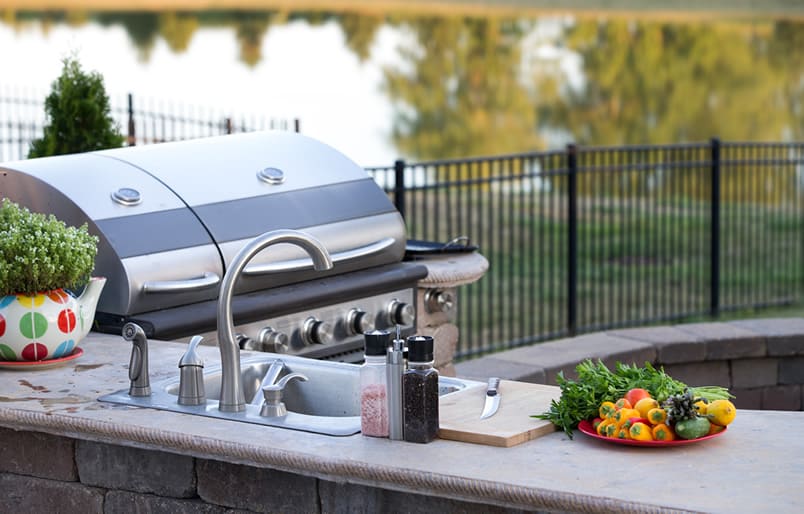
Concrete counters are another option you can explore for kitchens. Concrete countertops have flat, smooth work surfaces that come in precast form. They contain a mix of cement and fine and coarse aggregates like gravel and sand. This mixture is then molded into the desired shape and left to cure for 48 to 72 hours.
Concrete countertops can be reinforced by mixing in glass fibers into cement. This is called GFRC or glass fiber reinforced concrete. Reinforcement makes concrete countertops exceptionally strong despite being lightweight.
In addition to the added durability, reinforcement allows for more flexibility during construction — making it possible to create long, seamless spans of counters and bold overhang designs. Compared to ordinary concrete countertops, GFRC is less likely to crack.
Concrete counters come precast into flat, smooth work spaces surfaces. Concrete countertops are an energy efficient option as they can help control kitchen temperatures– concrete captures heat and releases it when things cool down. Concrete mostly resembles natural stone but a variety of colors can be achieved by adding pigments to the concrete mix.
Pros and Cons of Concrete Counters
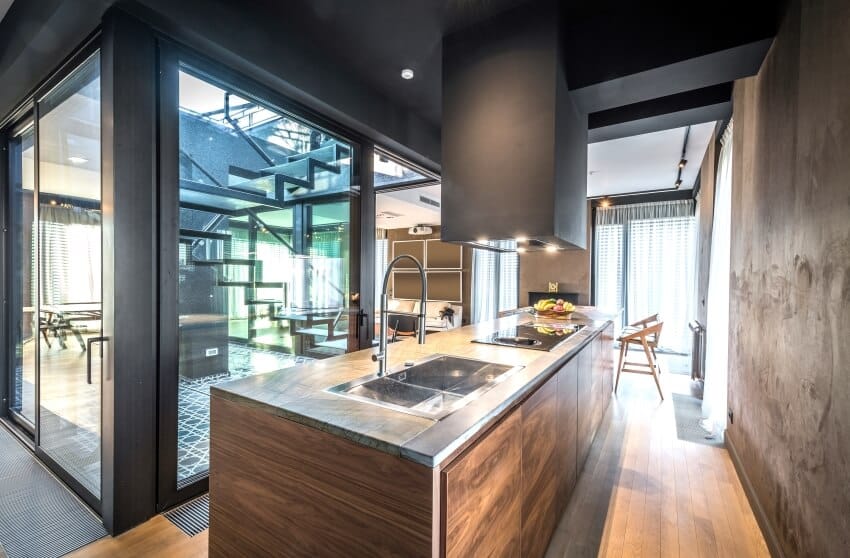
Concrete Countertop Pros
Long lasting – Concrete is one of the strongest construction materials. Its natural strength and durability is its top positive feature, making it one of the longest lasting countertops in the market.
Heat resistant – Concrete countertops will not get damaged from hot pots and pans . There will be no cracks when it comes in contact with hot objects.
Scratch resistant – In addition to being heat resistant, concrete is scratch resistant as well. Its natural strength lends it to be a good investment for a long-lasting countertop.There is no need to worry about sharp objects leaving scratches all over concrete countertops because they are highly resistant to it.
Energy efficient – Because concrete is an insulator, it is energy efficient and can help control kitchen temperatures.
Comes in a wide variety of colors – Concrete resembles natural stone but it can be dyed into different colors by adding pigments to the cement mix.
Highly customizable – The biggest advantage that concrete countertops have to offer is that the customization options are virtually endless.
You’ll be able to choose the exact shape, color and finish you want, pick a unique edge profile and add embellishments. Custom features can be cast to concrete countertops like trivets, cutting boards and drainboards.
No joints or seams – Concrete is the best material to use to create long spans of counters. Aside from the seamless look, this also adds a practical benefit because there will be no gaps or grout lines that may harbor the growth of bacteria.
Increases the value of your home – Concrete is considered a premium material and will add to the long term value of your home.
Concrete Countertop Cons
Vulnerable to stains – Although concrete counters are highly durable , they are vulnerable to stains. Spilled liquids need to be wiped right away to prevent them from permanently damaging your counter.
Needs to be sealed and resealed regularly – Similar to natural stone countertops, concrete countertops need to be sealed before use. You’ll also need to reapply sealer to protect its surface from staining and spills.
Your concrete countertops will need to be resealed every 1 to 3 years. Much like granite, without a good seal, you’ll probably see your counter stain easier- a particular concern for a kitchen, where spills can be frequent.
Installation takes time because it needs to be cured – Custom concrete countertops take time to cast and cure. If you need your countertop done quickly,this might not be the right option because the whole process will take a few weeks to complete.
Very expensive – Since concrete countertops are handcrafted, they require more labor, thus they are more expensive than other countertop materials.
May crack – Cracks may appear due to natural shrinkage but do not affect the countertop structurally. This can be avoided using reinforcement methods during construction.
Colors of Concrete
One of the biggest advantages that concrete countertops have to offer is customization. The options are virtually endless as it can be modified into any shape and design you want. Concrete can be left in its natural gray color but it can also be finished to resemble the look of wood, marble and granite.
When it comes to colors, pigments can be added to the mix or applied to the surface of cured concrete using stains or dyes. Because of these, the color options available for concrete countertops are endless — from neutrals like black, brown and gray to bold colors like red, green, blue, yellow and more.
Aside from the wide variety of colors, textures and finishes can also be added to concrete countertops from decorative stone embellishments and stone aggregates.
With such flexibility and design versatility, concrete countertops can match any design style including traditional, rustic, contemporary, modern and industrial,
Cost of Concrete
The cost of concrete countertops can be a hefty one but they are worth the investment. Estimates for its price ranges between $75 to $150 per square foot but specialized designs can cost more.
In general, concrete countertops are more expensive than marble and granite. The high price is not because of the material but because of the skill and creativity of the artisan making it.
Several factors play a role in the final cost of concrete countertops like the size, shape, color , finish and thickness of the countertop. Additional designs like edge profiles, inlays, decorative aggregates and backsplashes can also cause the price to increase.
Maintenance for Concrete
Concrete countertops have a naturally porous surface, to prevent them from absorbing any liquids, you’ll need to regularly apply sealer and wax every 1 to 3 years. Without a sealer, concrete counters will stain easier. For food prep areas, make sure to use food grade sealers.
If properly sealed, daily maintenance for concrete countertops is relatively easy. In fact, it is just like cleaning a laminated surface — all you need is a neutral ph cleaner and a soft cloth. Make sure to avoid scrubbing pads and abrasive cleaners because they can damage the sealer.
Glass Countertops
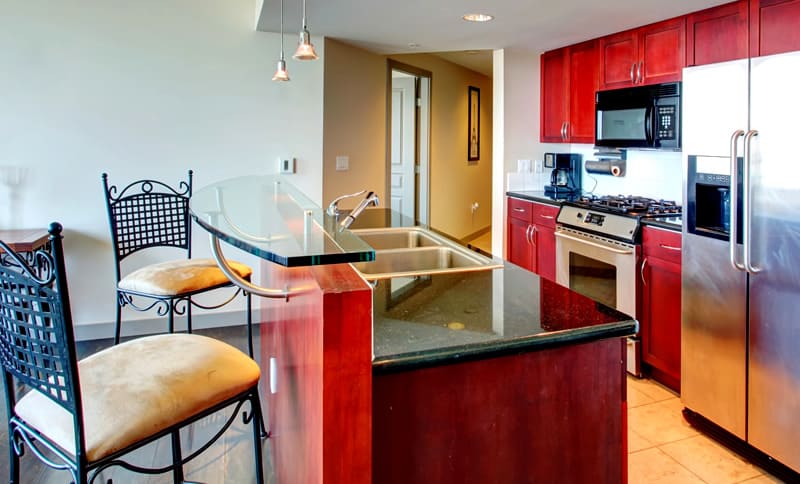
A glass countertop is a sleek and streamlined addition to any kitchen. Whether the glass is smooth, textured, translucent or colored, glass countertops can create a big statement in a kitchen.
Glass can be cut into almost any shape and texture and also comes in a variety of colors. Glass is easy to keep clean and its non-porous surface is stain-resistant and hygienic.
Glass countertops also offers benefits such as being highly heat resistant. It’s also incredibly lasting. It doesn’t typically show any natural wear over the years and they don’t warp or shrink. Glass counters are also eco-friendly since they are typically made out of recycled materials.
It isn’t all perfect, though. While durable, particularly sharp or heavy objects dropped on the counters can damage them and if that damage can be repaired, it needs to be done by a professional hand. Installation costs of glass kitchen countertops are also generally high.
Pros and Cons of Glass Kitchen Countertops
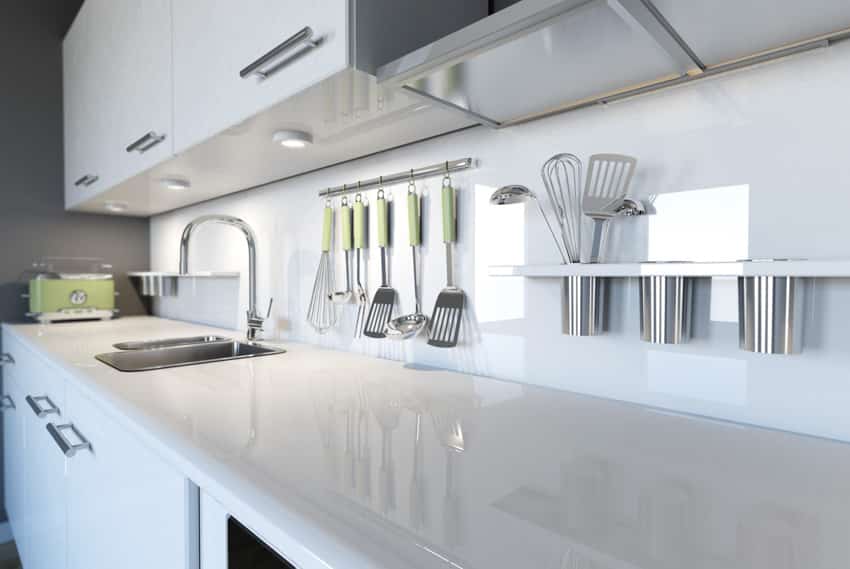
Below are some of the reasons to use glass kitchen countertops along with some precautions.
Glass Countertop Pros
Highly customizable – Glass can be cut into almost any shape and texture and also comes in a variety of colors.
Low maintenance– Glass is easy to keep clean. Being non-porous, they prevent the growth of bacteria, making them very hygienic and very easy to clean.
Non porous – its non-porous surface is stain-resistant and hygienic. There is no need to rush wiping spills because glass countertops will not absorb them.
Heat resistant – Glass countertops also offer benefits such as being highly heat resistant.
Long lasting – It’s also incredibly lasting.
Does not warp or shrink – It doesn’t typically show any natural wear over the years and they don’t warp or shrink.
Eco friendly – Glass counters are also eco-friendly since they are typically made out of recycled materials.
Wide variety of design options – With so many colors and types available, you have an endless variety of glass countertops to choose from.
Glass Countertop Cons
May chip or crack if objects are dropped on it –While durable, particularly sharp or heavy objects dropped on the counters can damage them and if that damage can be repaired, it needs to be done by a professional hand.
Needs to be replaced onced damaged – Glass countertops can crack or chip and when that happens it can be difficult to repair. Worst case scenario. You might need to replace the whole piece once damaged.
Expensive – Installation costs of glass kitchen countertops are also generally high
Must be done by a professional – Glass is extremely fragile that is why installation is recommended to be done by a professional.
Colors of Glass
Glass comes in almost any color from soft neutrals to vivid reds, bright oranges , refreshing greens, etc. With such, you can surely find the right one to match your kitchen’s color scheme and style.
Aside from the diversity of colors, glass also comes in different types, namely crushed glass, back painted glass and textured glass.
Crushed glass is made with recycled pieces of glass that is set on concrete or acrylic. It gives a mosaic like look and an appearance of glass floating in liquid.
Back painted glass is what its name suggests – the back of a glass panel is coated with paint to give it a solid, opaque color. This is perfect if you want a simple, clean yet very attractive countertop.
Textured glass , also known as patterned glass or decorative glass, is made by placing a piece of glass over a textured mold to produce different designs like swirls, dimples, water like textures , etc. Textured glass offers a super contemporary look and is a unique way to add statement to your kitchen.
Cost of Glass
The average cost of glass countertops is about $90 per square foot depending on the design and type of glass to be used. For labor and installation, expect to pay an additional amount of $10 to $30 per square foot.
Maintenance for Glass Counters
Glass countertops are one of the easiest materials to maintain. All you need is water and vinegar to keep it looking its best. Make sure to use distilled water to avoid streaking. Stains and spills can be removed by wiping with a soft cloth and water with soap solution.
Recycled Material Countertops
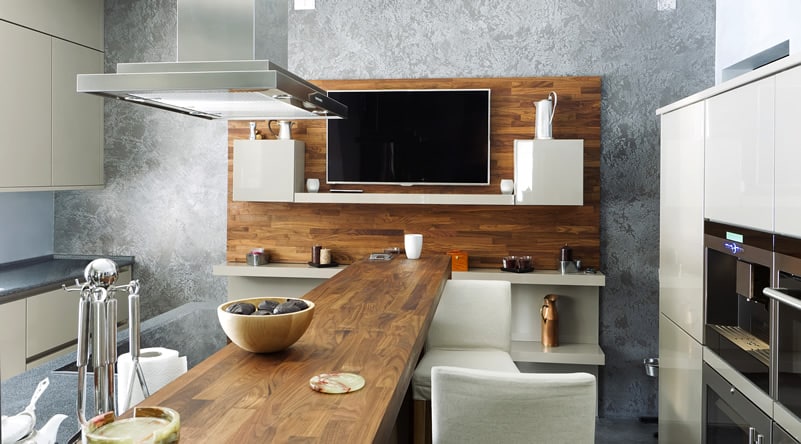
Recycled countertops are mainly composed of a mix of sustainable materials such as glass, wood, paper, plastic and cement. An eco-friendly choice, a recycled counter is also durable and easy to clean. Coming in a wide range of colors and textures, a recycled counter can easily fit almost any kitchen design.
What Are Recycled Materials
Reclaimed Wood – Reclaimed wood is wood that had been salvaged and repurposed. This is typically saved from demolished structures like old barns and vintage buildings. Reclaimed wood is the perfect countertop material for rustic kitchens because of their aged, timeworn look.
The surface can be used as a cutting board provided that it is resealed frequently because it can easily burn, stain, split and get damaged from moisture. The biggest benefit that reclaimed wood countertops have to offer is their timeless appeal.
Recycled Glass – Recycled glass countertops are composed of pieces of glass mixed with concrete and then cast into slabs. They look similar to natural stone and are also very durable.
Recycled glass countertops do not only offer a unique look but are also available in a wide range of colors and do not need to be sealed. They last for decades and are non porous and heat resistant.
Paper Composite – An excellent alternative to laminate countertops are paper composite countertops. They are a more eco friendly and safer option because they do not contain formaldehyde which can compromise the air quality of your home.
Paper composite countertops are equally durable as laminate countertops but when impregnated with resin, they become waterproof and heat resistant.
Advantages and Disadvantages of Recycled Countertops

Recycled Countertop Pros
Custom design – All of them offer unique style
Environmentally Friendly – These materials are mostly considered eco friendly.
Durable – The majority of these materials are long-lasting and durable. However, some materials such as wood can be very susceptible to moisture. Glass can also be easily scratched.
Recycled Countertop Cons
Difficult to repair – The negatives of recycled materials vary depending on what the counter you are buying is made up of specifically. For instance, recycled glass can be expensive to repair and susceptible to scratches.
Not heat resistant – A big problem that many run into with countertops of recycled materials is that they don’t handle high heat well. This means that a hot pan can often cause damage.
Limited choices – There is not a wide variety of recycled materials available that are easy to find.
Costly – While one would think that using recycled materials would be inexpensive that is often the opposite of the truth. Companies that procure these unique custom surface often charge a premium for their efforts.
Colors of Recycled Material
Recycled countertops are available in a wide myriad of colors and each one varies depending on the type of material used.
Reclaimed wood, for example, has more limited options because they typically come in medium to dark shades of gray. Recycled glass and paper composites have more diverse colors and virtually come in any color.
Cost of Recycled Surfaces
Recycled glass is generally expensive and costs as much as granite, with average prices ranging between $65 to $140. On the other hand , the cost or reclaimed wood countertops vary widely, but expect to pay anywhere between $30 to $140 per square foot.
If you want a more budget friendly option, you can repurpose wood you already have. Paper based composite countertops are priced in the low to mid range and typically run between $30 to $80 per square foot installed.
Maintenance for Recycled Countertops
Both recycled glass and paper composite countertops do not need to be sealed, however reclaimed wood needs to be treated before use to give it added protection against moisture.
With regards to daily maintenance, you can clean recycled countertops with warm, soapy water and a soft cloth. Avoid using abrasives because they may damage the surface.
Soapstone Countertops
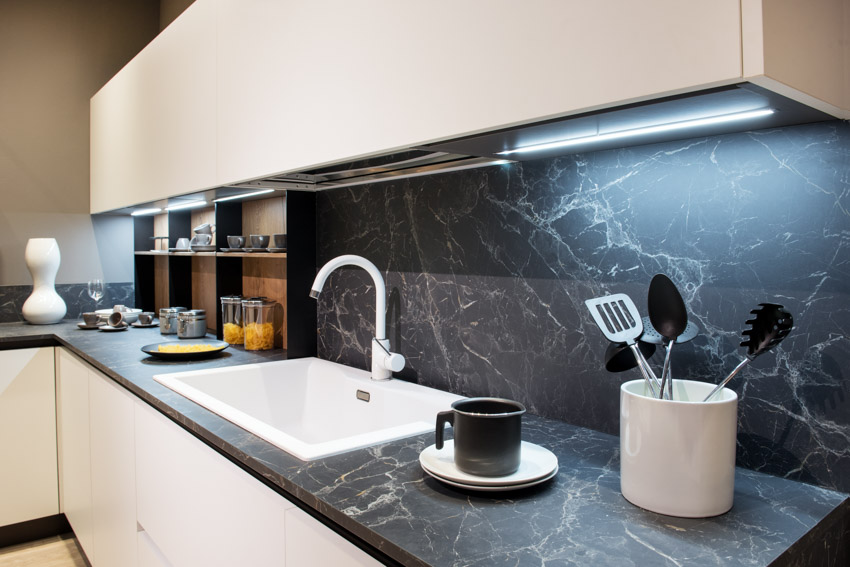
Named after a bar soap, soapstone is one of the warmest countertops options in the market. Soapstone is a type of metamorphic rock that contains 50% talc — the softest mineral.
Although it has a rating of between 1 to 5 in the Mohs Hardness scale, the particles that make up soapstone are very dense and compact, which gives it an impenetrable and durable surface.
Within every slab of soapstone, the amount of talc varies, and the slabs used for countertops are within the harder range. The varying levels of hardness is due to the presence of different minerals like mica, quartz, carbonates, chlorites and amphiboles.
Pros and Cons of Soapstone
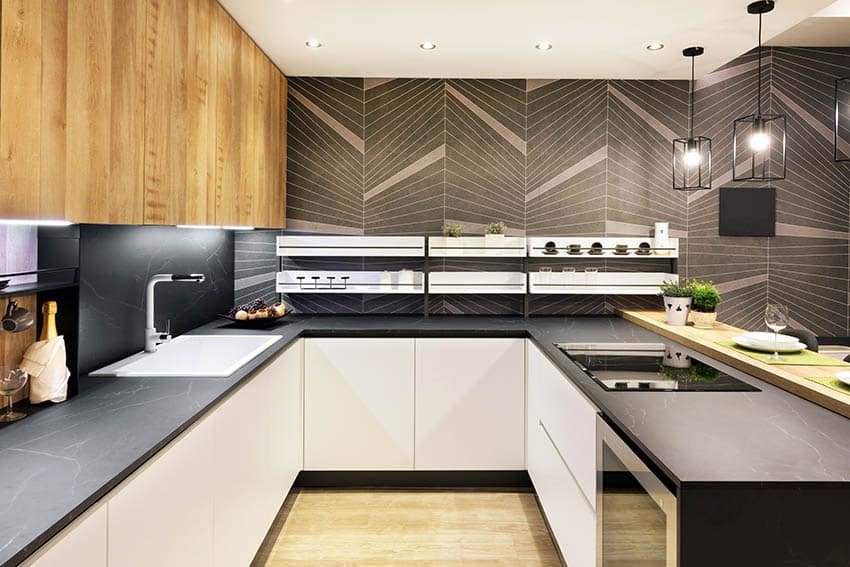
There are many advantages and some disadvantages to using soapstone for a kitchen countertop.
Soapstone Countertop Pros
Dramatic look – Soapstone has a dramatic, timeworn aesthetic that is perfect for recreating Old World interiors and country kitchens. It also offers an amazing amount of warmth which can make kitchens look cozy and inviting.
Ages gracefully – The surface produces a natural patina which adds to it rustic appeal.
Non Porous – You’d be surprised to learn that soapstone is the only natural stone that is inherently resistant to moisture.
Stain resistant – Soapstone is impermeable and highly resistant to staining so it will not get damaged from oil , wine and other spills.
Does not need to be resealed – Soapstone is the only natural stone that does not need to be sealed and resealed.
Heat resistant – It stands up to heat well, in fact you can put a hot pan on it without damaging its surface.
Less brittle – It will not crack from unexpected weight and sudden impact.
Can be recycled – Soapstone is 100% natural and can be repurposed.
Highly customizable – While not as hard as granite, soapstone is more pliable and easy to carve, so it can be customized with added features like sinks, drain boards and soap dishes for a more seamless look.
Easy to clean – It only needs simple tools and materials to keep it looking clean on a daily basis.
Hygienic – Soapstone is a very sanitary countertop and does nit harbor the growth of harmful bacteria.
Soapstone Countertop Cons
Lack of color options – The color options for soapstone are very limited, unlike other natural stones like granite and manmade countertops materials like quartz and solid surfaces.
More expensive than other materials – Soapstone is more expensive than granite, marble and quartz.
Soft countertop material – Since it is a softer material it can be easily scratched. Higher talc content surfaces will help prevent easier scratching.
Colors of Soapstone
Soapstone has a limited range of color options — most of which are dark. It also comes in beautiful neutrals which range from pure white with a bit of marbling to charcoal gray.
Some other options include shades of white, off whites and grays. Soapstone comes in almost solid colors to rich,dramatic marbling. Although available in less color options, soapstone can be used in different styles that range from traditional to modern to eclectic.
Cost of Soapstone
Soapstone is generally more expensive than other countertop materials. The price point for soapstone countertops is equivalent to high end granite and quartz, running at an average of $72 to $150 per square foot, installation included.
Maintenance for Soapstone
Daily maintenance for soapstone countertops is relatively easy. Because it is non porous, all you need is mild soap and a soft cloth or sponge. Because it is chemically neutral, acidic substances like vinegar or lemon juice won’t stain and leave blemishes on its surface.
The only special care that soapstone countertops need is oiling . Periodic application of mineral oil will keep it looking its best. As the years go by, the stone produces a natural patina which adds to its beauty.
New soapstone countertops need to be coated with mineral oil about once a week. You can do this using a clean rag and make sure that the surface is evenly coated. Any excess oil can be removed with a paper towel.
The frequency of oiling will depend on the color of your stone. The darker you want your countertop to be, the more it needs to be oiled because oil will help the surfuce to oxidize to produce a rich charcoal color. Mineral oil can be found in hardware stores and pharmacies. You can also use it to remove minor scratches.
Resin Countertops

Resin is one of the newest innovations in countertop materials. It is a popular choice for DIY-ers because it often comes in kits.
Resin countertops are crafted from acrylic, polyester resin and epoxy. The countertops are customized and made to order according to your preferred shape and design.
Advantages and Disadvantages of Resin Countertops
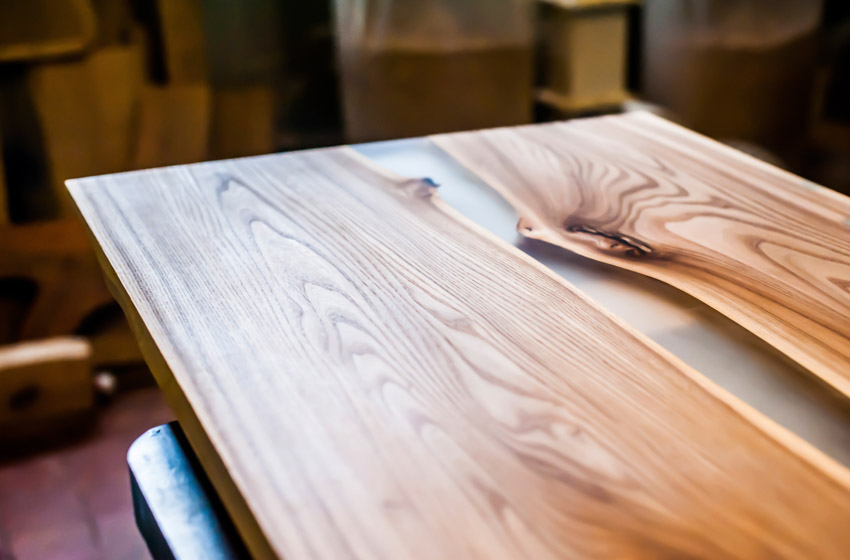
Below are the pros and cons of using resin for kitchen countertops.
Resin Countertop Pros
Does not need professional installation – Resin countertops can be a fun project for homeowners where they can freely express their creativity.
Highly customizable – Can be easily customized according to one’s preferred design and size.
Durability – Resin countertops are impact resistant and resists wear and tear very well.
Stain resistant and non porous- Spilled liquids, including acidic substances are the least of your worries because resin countertops will not absorb them.
Scratch resistant – It does not get damaged from sharp objects.
Heat resistant – Even if it comes in contact with hot pots and pans, resin countertops will not melt, burn or mark.
Unique appearance – Resin countertops offer the most design flexibility and versatility, thus offering a very unique countertop option.
Affordable – resin countertops are a budget friendly option with costs lower than other materials.
Resin Countertop Cons
Requires great attention to detail – To get flawless results, you need great attention to detail and care because bubbles can form on it.
Installation is messy – All the work needs to be done on site and installation can get quite messy.
Lack of consistency among products – Not all resin countertops are created equal. Some are made with acrylic, some with polyester.
Requires special maintenance – It takes effort to keep resin countertops from looking their best.
Colors of Resin
Because resin is synthetic, it can be made into any color. In fact, there are hundreds of choices available. The epoxy can be tinted or completely colored to produce the exact shade and look one prefers.
The level of color can be regulated to produce different effects from solid colors to a semi translucent finish. The lesser the pigments, the more translucent it becomes.
Cost of Resin
Resin countertops usually cost $100 to $200 per kit — a fairly affordable option when it comes to kitchen countertops. Although the kits are budget friendly, the labor costs for such is a bit high if you choose to outsource the work. Expect to pay as much as $100 per square for the installation alone.
Maintenance for Resin
A simple dish soap and warm water solution will do the trick for most resign countertops, but to keep the surface in best shape, you’ll need to apply Murphy’s oil weekly. Make sure to use the right amount to prevent the surface from looking hazy.
In the vent of spills, make sure to wipe it immediately using the right type of cloth. A chamois cloth is one of the best fabrics to use because it is gentle on the surface and highly absorbent.
Do not use alcohol because it can clean off any epoxy resin from the surface. Also avoid abrasives, scouring pads and all purpose cleaners because they will dull the surface of the countertops. Polishes with wax or wax itself is another no-no for resin countertops.
Tile Countertops

There are many tile options in the market but in general, the two most used are ceramic and porcelain with the latter being the more recommended choice because of its impenetrability.
Porcelain tiles are made with a mixture of kaolin clay with notable amounts of quartz and feldspar mixed in. Porcelain tiles are fired at high temperatures ranging from 2,000 degrees Fahrenheit to 2,500 degrees Fahrenheit. Compared to ceramic tiles, porcelain tiles are much denser and have an absorption rate of less than 0.5 percent.
Pros and Cons of Countertops Made Of Tile
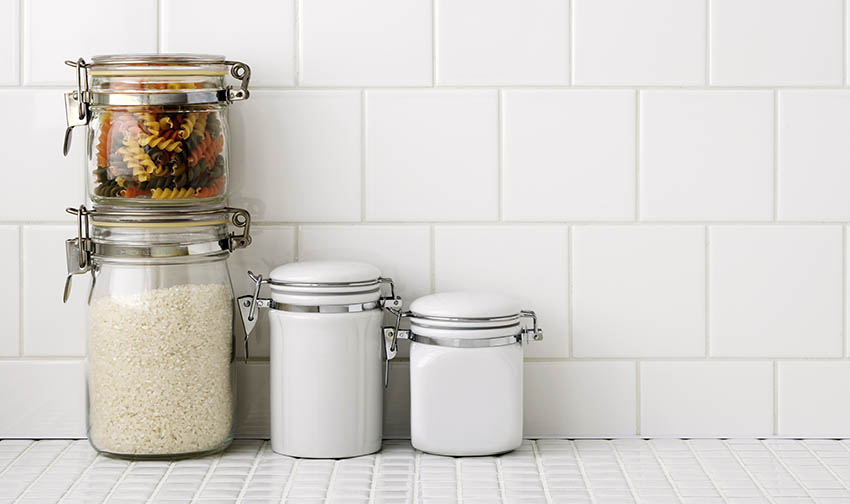
There are some pluses of using tile countertops and a couple minuses which we cover below.
Tile Countertop Pros
Variety – Porcelain tiles come in a wide variety of design, colors, patterns, shapes, sizes and prices.
Non porous – Porcelain tile countertops have a very low absorption rate and wont get damaged from spills.
Easy to replace – If one tile gets damaged, you do not need to replace the whole slab.
Affordable – Tile countertops are a very budget friendly option and costs less than natural stone.
A good way to add pattern to a space – Tile countertops are a good way to add patterns and texture to a kitchen.
Tile Countertop Cons
Less durable than some other countertops – Tile countertops may chip if banging pots and pans around.
Appearance of grout joints – Maintaining grout joints and seams adda bit of work because of their tendency to harbor harmful bacteria. Additionally, grout lines prevent you from creating a flawless and seamless countertop design.
Uneven surface – Tile countertops do not have a smooth surface because of the grout space between each tile.
Out of Style – Many types of tile countertops appear outdated and are not as appealing as newer kitchen surface materials.
Colors of Tile
Ceramic tile kitchen countertops are available in different colors which range from neutral to bold colors. In addition to the endless color options, it also comes in different patterns and designs.
With a wide variety of choices, You can use tiles to create an interesting countertop that matches any interior style and color scheme.
Cost of Tile
Porcelain tiles are less expensive than other countertop materials and are considered to be one of the cheapest options in the market.
Depending on the tile you choose, the cost ranges as low as $1 per piece for the material alone. The average cost to install a tile countertop is between $15 to $27 per square foot.
Maintenance for Tile
To keep tile countertops looking beautiful you’ll need to clean them regularly with non abrasive materials like a soft cloth. All you need is some mild dish detergent and water to keep it looking its best. Spills can be wiped with a soft cloth, sponge or even disinfecting wipes. Make sure to wipe them off immediately to prevent any stains.
The most difficult part to maintain in tile countertops are the grout lines because they are very porous and can harbor the growth of bacteria. Prevent mold and mildews by cleaning the seams frequently using foam spray, grout cleaner or a little bleach.
Alternatively, baking soda mixed with vinegar is also another effective cleaning solution. You can apply it using a toothbrush and gently scrub the grout until it’s clean.
To prevent heat damage, always use a trivet on your tile countertops. Although porcelain tolerates relatively high temperatures well, burn marks can still appear especially with direct contact with fire.
What Is the Best Countertop for a Kitchen?
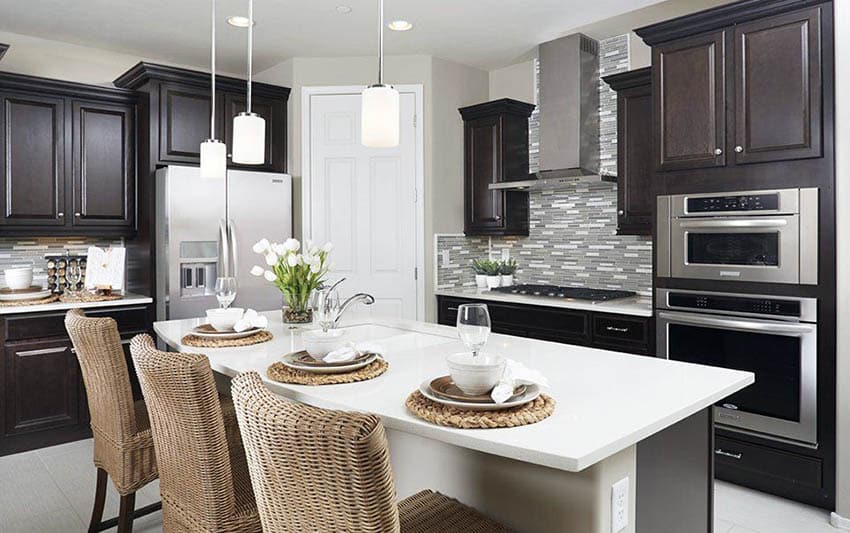
When it comes to sheer popularity, quartz takes the cake as the most often used material according to the National Kitchen and Bath Association. This recently passed another popular option: granite.
These countertops, as we’ve covered, are affordable and functional. The least popular options are some of the more expensive options such as glass and concrete. However, these materials are great for an aesthetically impressive countertop.
What Is the Most Durable Countertop?
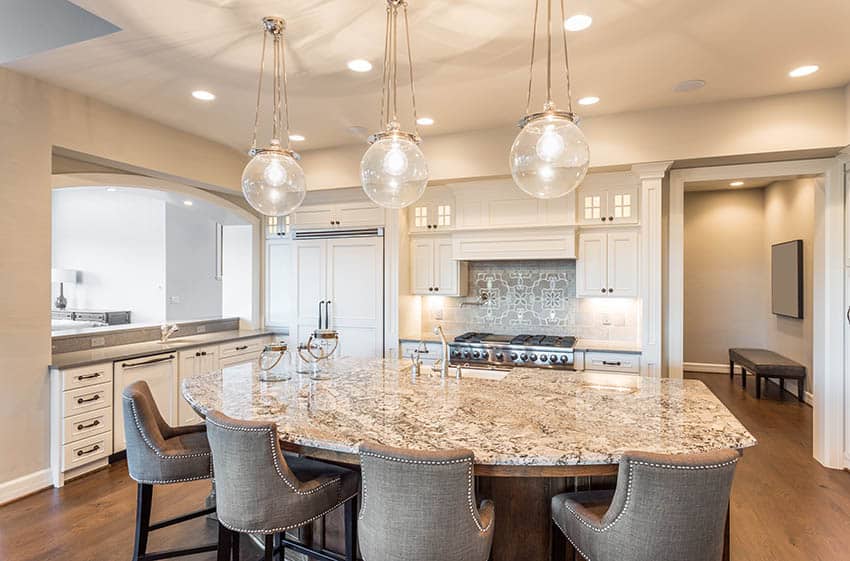
Generally, quartz is considered the strongest when it comes to handling the danger of chips and cracks. Yet, it isn’t the most heat-resistant option and if your kitchen has plenty of windows, you might see discoloration from sunlight.
Close behind quartz, once again, is granite. This option is more heat-resistant but its more likely to chip and it must be sealed regularly.
What Countertop Is the Easiest to Maintain?
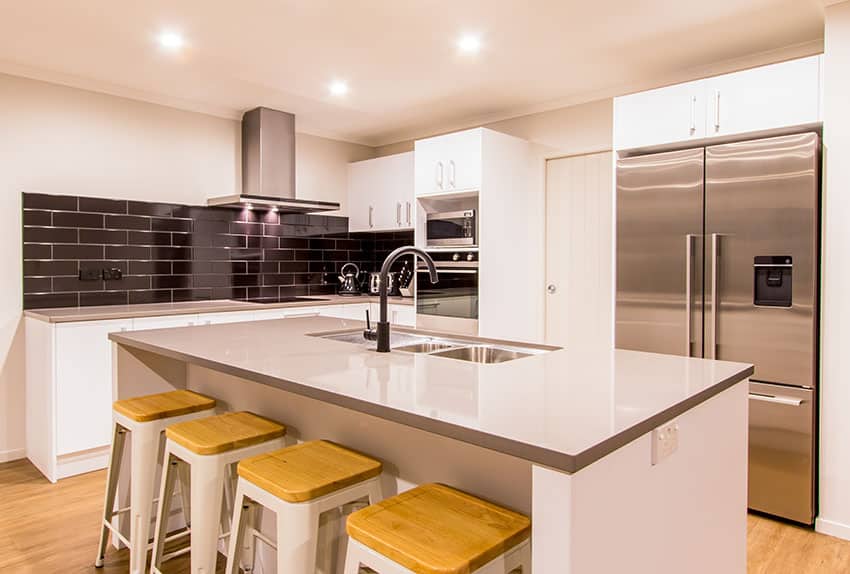
The easiest option you have is laminate countertops. These don’t need to be resealed and they are non-porous. This makes them easy to wipe down after a night of cooking.
What Is the Most Affordable Countertop?
Finally, we will look at what countertop will cost you the least. Once again, laminate countertops win out. One of the best ways to save when choosing an affordable laminate countertop is to go to a home improvement store or online and look for “pre-lammed” slabs. You can also look to home design stores such as IKEA.
As a bonus, these countertops are fairly simple to install, saving you on installation costs as well. To be fair, there are more expensive laminate countertops when you choose premium or high-definition designs.
Best Kitchen Countertops Infographic:


